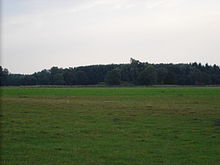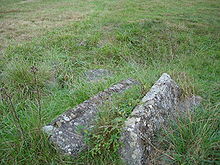Münster-Handorf airfield
|
Münster-Handorf Airport Münster-Handorf Air Base Training area for the Lützow barracks |
||
|---|---|---|
|
|
||
| Characteristics | ||
| Coordinates | ||
| Height above MSL | 53 m (174 ft ) | |
| Transport links | ||
| Distance from the city center | 2 km east of Handorf | |
| Street | (today's |
|
| Basic data | ||
| opening | April 4, 1937 | |
| closure | 1946 (as an airfield) | |
| operator | Royal Air Force (last) | |
The Münster-Handorf Airfield is a former traffic airfield, airbase of the Air Force and Nike -Abwehrstellung in the suburb Handorf the Westphalian city of Münster . Today it serves as a training site .
history
Beginnings
The history of the airfield goes back to 1934. When the then airfield of the city of Münster on Loddenheide became too small and could no longer meet the requirements of aviation, the search for a suitable site for the construction of a larger airfield began. The choice fell on a site in the area of the then still independent municipality of Handorf, a few kilometers east of Münster. After the decision to build it was made in November 1934, construction work began in 1935 by the Münster-Handorf Airport GmbH, which was specifically founded . The topping-out ceremony took place in September 1936, the construction work itself was completed on April 1, 1937. Just three days later, on April 4, 1937, the Münster - Berlin airline was opened.
The airfield itself consisted of two parts: a military part in the northwest corner of the field in the direction of Handorf and a much smaller civil part in the southeast corner, facing the town of Telgte . The civil part included a terminal building, a restaurant, the airport administration and an aircraft hangar.
Second World War
The military facilities, the air base , were not completed until 1938. The first stationed unit was a reconnaissance unit, equipped with Heinkel He 45 and Heinkel He 46 aircraft . In the following year the Jagdgeschwader 27 with its Messerschmitt Bf 109 moved to the air base in Handorf on October 1st, 1939 and stayed there until January 1940. After the withdrawal of the Jagdgeschwader on February 11th, 1940 the I./KG 27 "Boelcke" moved to Handorf that had previously been stationed at air bases in southern Germany. With the advance of the western front, this squadron followed towards the west at the end of May 1940.
From August of the same year, the air base in Handorf increasingly served as a base for various bomber formations, equipped with Heinkel He 111 . These included parts of the KG 54 “Totenkopf” and the KG 1 “Hindenburg” . IV./KG 1 was set up on August 16, 1940. It remained in Handorf until June 16, 1942. The stationing of the II. And III. The squadron's group took place some time later and did not last that long. The II. Group was stationed in Handorf between December 1940 and March 1941, the III. Group between October 1940 and January 1941.
A short time after the outbreak of the Second World War , the airfield was expanded. The previously unpaved runways were paved and in 1941 or 1942 the civil part that had only been built a few years earlier was demolished. By March 1942 at the latest, there was nothing left of the civil airfield.
After the expansion was completed, the III was stationed in August 1943 . Group of Kampfgeschwaders 3 (III./KG 3) with Junkers Ju 88 , which lasted until November 1944. During this time this unit was renamed several times, first in February 1944 to I. Group of Nachtjagdgeschwader 7 (I./NJG 7), then in October to IV. Group of Nachtjagdgeschwader 2 (IV./NJG 2). In the meantime, towards the end of 1943, parts of the II. Group of Kampfgeschwader 2 (II./KG 2) with Junkers Ju 188 were relocated to the air base in order to carry out the Steinbock operation . In September 1944 another unit was added with the I./NJG 1 with its Heinkel He 219 .
In addition to these units already stationed in Handorf, further units were added towards the end of 1944, including the KG 53 with its Heinkel He 111 in September 1944 and their conversion to Heinkel He 111 H-22. Between October and November the IV./NJG 2 moved to the air base in Handorf, which was then replaced by the III./KG 76 with their Arado Ar 234 , which launched the first attack by a jet-powered fighter-bomber from here on December 24, 1944 flew. The Messerschmitt Me 262 was also stationed in Handorf between November 1944 and February 6, 1945 in the form of the "Sonderkommando Braunegg".
The following table shows a list of selected active flying units (excluding school and supplementary units) of the Wehrmacht Air Force that were stationed here between 1938 and 1945.
| From | To | unit | equipment |
|---|---|---|---|
| September 1939 | February 1940 | Staff / KG 54 (Staff of Kampfgeschwader 54) | Heinkel He 111P |
| October 1939 | January 1940 | Staff / JG 27 (Staff of Jagdgeschwader 27) | Messerschmitt Bf 109E |
| October 1939 | October 1939 | Staff / JG 3 | Messerschmitt Bf 109E |
| November 1939 | February 1940 | Staff / JG 51 | Messerschmitt Bf 109E |
| December 1939 | January 1940 | I./JG 21 | Messerschmitt Bf 109E |
| February 1940 | March 1940 | I./KG 27 | Heinkel He 111P |
| May 1940 | May 1940 | III./KG 54 | Heinkel He 111P |
| June 1940 | June 1940 | III./KG 27 | Heinkel He 111P |
| September 1940 | October 1940 | III./KG 1 | Heinkel He 111H, Junkers Ju 88A |
| November 1940 | March 1941 | II./KG 1 | Heinkel He 111H, Junkers Ju 88A |
| December 1941 | February 1942 | I./KG 3 | Junkers Ju 88A |
| June 1942 | September 1942 | I./KG 1 | Junkers Ju 88A-5 |
| June 1943 | October 1943 | III./LG 1 | Junkers Ju 88A-4 |
| August 1943 | January 1944 | III./KG 3 | Dornier Do 217K-1, Junkers Ju 88A-4 |
| October 1943 | September 1944 | II./KG 2 | Junkers Ju 188E-1 , Dornier Do 217E-4 |
| February 1944 | September 1944 | I./NJG 7 (I. Group of the Nachtjagdgeschwader 7) | Junkers Ju 88A-4 |
| September 1944 | September 1944 | Staff, I./KG 2 | Dornier Do 217M-1 |
| September 1944 | March 1945 | I./NJG 1 | Heinkel He 219A-0 |
| October 1944 | November 1944 | IV./NJG 2 | Junkers Ju 88G-1, Junkers Ju 88G-6 |
| December 1944 | March 1945 | 9./KG 76 (9th squadron of Kampfgeschwader 76) | Arado Ar 234B-2 |
Since 1945

Although the airfield was repeatedly attacked by Allied bombers during the war, there was never any damage that had a serious impact on flight operations. However, aerial photos from 1953 document that the area was bombed very intensively. When the German troops withdrew on April 3, 1945, they blew up most of the buildings and technical facilities before the place was taken by American troops on April 5, 1945 . After the end of the war, the British army confiscated the site and used the undestroyed or partially repaired buildings to accommodate refugees and those in need. Parts of the airfield were now also used for arable farming.
The Airfield Y.94 , the name by the Allies, but was in the summer of 1946 temporarily again by Mosquito squadrons of the 140th Wing (wing) of the British Air Force of Occupation used because its home court Gütersloh then received a concrete runway.
Plans for the permanent reactivation of airfield operations led to resistance within the population, so that the area was cleared for the stationing of army units. This use began with the construction of the Lützow barracks in 1956, which included the buildings of the former air base. The barracks were completed in 1957.
The large open area of the airfield was still used by the military, even if not by airmen. In 1959, the first Nike position was stationed by the B-Battery of the 119th Squadron of the Dutch Air Force , but the associated nuclear warheads were managed by the A Team (also known as the Alpha Team) of the 509th Artillery Detachment / USAAD. At least between 1967 and 1973 a large DF antenna system was operated south of the rocket battery. The missile battery was active until 1975 when it was restructured and the Nike battery was withdrawn from Handorf. The vacant and partly dilapidated buildings were gradually demolished from the mid-1980s onwards and collected into three piles of rubble on the former bunker complex. During this period, parts of the former airfield were demunitioned to ensure that the Lützow barracks could be used by the infantry troops. This sieved gravel was also collected on the rubble mountains. The last building - a control center for the Dutch missile battery on the northwestern edge of the position - was only demolished in 1998.
The area of the airfield was meanwhile used for target exercises by the 194 Panzer Battalion , but this led to astonishment among the neighboring population of Handorf, because they believed they were in the imaginary target area. The area also served the soldiers as a place to set up a tent city during a NATO exercise in 1996. In 2006, extensive landscaping measures were carried out: Several bodies of water were created and numerous large wood bars were planted around the previously very open landscape of the former airfield upgrade the training infantry of the Lützow barracks. On February 4, 2007, the Fisherman's Friend Strongman Run took place on the grounds with almost 1,600 starters and around 12,000 spectators. For ecological reasons, this event was no longer held here in the following years. The site is currently used as an on-site practice area and is open to the public on weekends and outside of practice times. The surviving accommodation buildings of the Dutch Nike position on the southern edge of the site are used by the technical relief organization. The North Rhine-Westphalia Fire Brigade Institute operates its training area in the immediate vicinity.
literature
- Christian Chmela: Floristic and vegetation studies study of the training site "Handorf Ost" near Münster (Westphalia) and creation of a development and maintenance concept. Unpublished Diploma thesis Univ. Bonn, 1996.
Web links
Individual evidence
- ↑ Henry L. deZeng IV: Air Force Airfields 1935-45 Germany (1937 Borders) , accessed on August 29, 2014.


